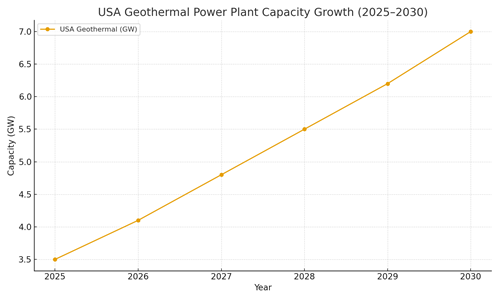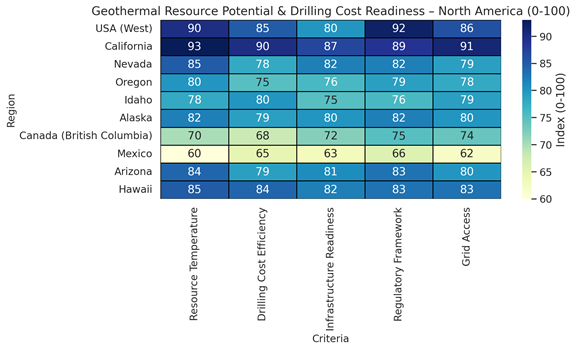

68 Circular Road, #02-01 049422, Singapore
Revenue Tower, Scbd, Jakarta 12190, Indonesia
4th Floor, Pinnacle Business Park, Andheri East, Mumbai, 400093
Cinnabar Hills, Embassy Golf Links Business Park, Bengaluru, Karnataka 560071
Connect With Us
Geothermal Power Plant Optimization Strategies: Reservoir Management & Drilling Cost Reduction
Geothermal energy is emerging as a key solution for decarbonizing the power sector in North America, with the USA poised to lead the charge in scaling geothermal plants through 2030. As a highly reliable and baseload power source, geothermal is expanding its footprint, particularly in western USA, where vast untapped resources exist. Key optimization strategies, including enhanced drilling techniques, reservoir management innovations, and the implementation of CO2-assisted drilling, will help lower costs, improve drilling efficiency, and increase the energy output from geothermal wells. Technological advancements in drilling cost reduction will play a major role in making geothermal more economically viable. Horizontal drilling, advanced drilling bits, and reservoir stimulation technologies are expected to reduce drilling costs by 20-30% by 2030. Enhanced Geothermal Systems (EGS) and CO2-assisted drilling technologies, while still emerging, hold the potential to revolutionize geothermal power production by unlocking deeper, hotter reservoirs.

What's Covered?
Report Summary
Key Takeaways
1) Geothermal energy in North America will grow significantly through 2030, with USA leading in capacity expansion.
2) Drilling cost reductions of 20–30% will be driven by advanced drilling technologies, including horizontal drilling and new drilling bits.
3) Enhanced Geothermal Systems (EGS) and CO2-assisted drilling will unlock deeper reservoirs and increase energy production.
4) Reservoir management innovations will help maintain high energy extraction rates and prolong well life.
5) California, Nevada, and Oregon will lead the USA in geothermal growth, with supportive policies and existing grid infrastructure.
6) Geothermal drilling and energy extraction efficiency will improve through technological innovation and scale.
7) Geothermal power is set to become a major contributor to North America's clean energy portfolio by 2030.
8) Regulatory frameworks, incentives, and grid integration will play a significant role in accelerating geothermal development.
Key Metrics

Market Size & Share
The USA is set to lead the geothermal market in North America, with a substantial increase in capacity over the next decade. As of 2025, the total installed geothermal capacity in the USA is expected to be around 3.5 GW, growing to 7.0 GW by 2030, driven by the need for baseload renewable energy sources. California, Nevada, and Oregon will be the primary regions driving this growth, thanks to favorable geological conditions, existing infrastructure, and strong policy support. The growth of geothermal power will also be supported by the development of Enhanced Geothermal Systems (EGS), which will open up new, deeper resources.
The market share for geothermal power will continue to grow as drilling costs decrease and new technologies are implemented. By 2030, geothermal will contribute significantly to the renewable energy mix in the USA and Canada, alongside wind and solar, providing a reliable and cost-effective solution for decarbonizing power generation.

Market Analysis
Geothermal drilling costs are expected to reduce significantly by 2030, as advanced drilling technologies, including horizontal drilling and new, more efficient drilling bits, are adopted. In 2025, drilling costs are estimated to be around $250 per meter drilled, but with technological improvements, costs will fall to $150 per meter by 2030. The implementation of Enhanced Geothermal Systems (EGS) and CO2-assisted drilling technologies will further reduce costs, particularly in deeper, more challenging reservoirs. These advancements will make geothermal energy even more competitive against other renewable sources.
Along with cost reductions, geothermal energy's levelized cost of electricity (LCOE) is expected to decrease as drilling and energy extraction efficiency improves. By 2030, geothermal LCOE is expected to be approximately $60–70 per MWh, making it a highly competitive energy source in North America.

Trends & Insights (2025–2030)
• Technological advances in geothermal drilling will lower costs and increase energy output from wells, making geothermal energy more economically viable.
• Enhanced Geothermal Systems (EGS) and CO2-assisted drilling technologies will unlock deeper, hotter geothermal resources.
• Geothermal power plants will continue to be an important source of baseload renewable energy in North America, particularly in California, Nevada, and Oregon.
• Policy support, including tax incentives and renewable energy targets, will play a key role in accelerating geothermal adoption.
• Geothermal drilling and reservoir management innovations will be key to improving well longevity and maximizing energy extraction.
• The integration of geothermal power with other renewable sources like wind and solar will enhance grid stability and reduce intermittency.
• Growing interest in geothermal energy will drive increased investments in infrastructure and technology development.
Segment Analysis
• Utility-scale Geothermal: Large geothermal power plants will be developed primarily in California, Nevada, and Oregon. These plants will play a key role in providing baseload renewable energy to the grid.
• Geothermal for District Heating: Geothermal energy will also be used for district heating applications, particularly in colder regions with high geothermal resource potential.
• EGS and CO2-assisted Drilling: These technologies will be increasingly adopted to access deeper, hotter geothermal resources that were previously uneconomical to exploit.
• Residential & Commercial Geothermal Heating: The use of geothermal heat pumps will expand in residential and commercial applications, providing an efficient and sustainable heating solution.
• Geothermal in Oil & Gas: CCUS and enhanced oil recovery (EOR) techniques will be combined with geothermal energy to reduce emissions in the oil and gas sector.
Geography Analysis (USA & North America)
North America's geothermal potential is vast, with regions like California, Nevada, and Oregon hosting the largest geothermal resources. California, in particular, has a rich geothermal history and will continue to be a leader in geothermal power generation. Other states like Idaho, Alaska, and Utah also show great promise for geothermal development, with new projects beginning to emerge in response to growing demand for clean, renewable energy. Oregon's efforts to promote geothermal energy through policy incentives will contribute to the region's continued growth. Geothermal growth in North America will be further supported by the development of EGS, which will unlock deeper, more challenging geothermal resources. Canada and Mexico are also expected to see growth in geothermal power generation, particularly in regions like British Columbia, Alberta, and Sonora.

Competitive Landscape (Ecosystem & Delivery Models)
The geothermal energy market in North America is composed of developers, technology providers, EPC contractors, and service providers. Leading geothermal developers in North America include companies like Ormat Technologies, Calpine Corporation, and Enel Green Power. The geothermal supply chain also includes technology providers for drilling, reservoir management, and power generation equipment, as well as EPC contractors that help build and maintain geothermal power plants. The competitive landscape is evolving as new technologies like EGS and CO2-assisted drilling come to the forefront. Companies that specialize in these technologies will gain a competitive advantage in accessing new geothermal resources. Additionally, partnerships with oil and gas companies may be formed to explore the use of geothermal resources for enhanced oil recovery (EOR) and CCUS.
Report Details
Proceed To Buy
Want a More Customized Experience?
- Request a Customized Transcript: Submit your own questions or specify changes. We’ll conduct a new call with the industry expert, covering both the original and your additional questions. You’ll receive an updated report for a small fee over the standard price.
- Request a Direct Call with the Expert: If you prefer a live conversation, we can facilitate a call between you and the expert. After the call, you’ll get the full recording, a verbatim transcript, and continued platform access to query the content and more.


68 Circular Road, #02-01 049422, Singapore
Revenue Tower, Scbd, Jakarta 12190, Indonesia
4th Floor, Pinnacle Business Park, Andheri East, Mumbai, 400093
Cinnabar Hills, Embassy Golf Links Business Park, Bengaluru, Karnataka 560071
Request Custom Transcript
Related Transcripts
$ 1345
$ 1432
$ 1450


68 Circular Road, #02-01 049422, Singapore
Revenue Tower, Scbd, Jakarta 12190, Indonesia
4th Floor, Pinnacle Business Park, Andheri East, Mumbai, 400093
Cinnabar Hills, Embassy Golf Links Business Park, Bengaluru, Karnataka 560071







.png)





